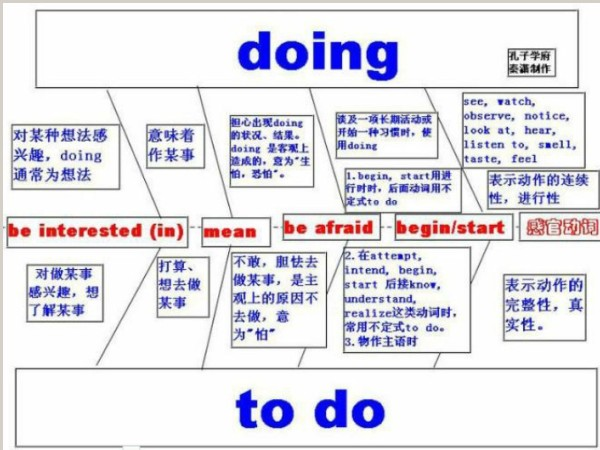本试题 “It was _____ the second-hand bus that the mechanic spent the whole afternoon in the factory.[ ]A. in repairB. repairedC. repairingD. to repair” 主要考查您对动名词
强调句
等考点的理解。关于这些考点您可以点击下面的选项卡查看详细档案。
- 动名词
- 强调句
动名词概念:
动名词是一种兼有动词和名词特征的非限定动词。它可以支配宾语,也能被副词修饰,动名词有时态和语态的变化。
现在分词和动名词用法比较:
动词的-ing形式包括现在分词和动名词两种形式。他们的句法功能如下:
动词的-ing形式如果作句子的主语或者宾语时,应该是动名词形式;如果作补语或者状语时,应该是现在分词形式。那么作表语或者定语的动名词和现在分词又该怎样区分呢?
1、动名词与现在分词作表语时的比较:
(1)动名词作表语说明主语的内容,回答what的问题;现在分词作表语相当于形容词作表语,说明主语的性质、特征等,回答how的问题。
如:One of the best exercises is swimming. 游泳是最好的运动项目之一。
What pleases him most is bathing in the sea. 最使他高兴的事是在海中沐浴。
The situation both at home and abroad is very in-spiring. 国内外的形势都很鼓舞人心。
The color is pleasing to the eye. 颜色悦目。
(2)动名词作表语,表语和主语几乎处于同等地位,可以互换位置,其句意不变;现在分词作表语,表语和主语则不能互换位置。
如:Our work is serving the people.
(=Serving the people is our work.)我们的工作是为人民服务。
The news was disappointing. 那消息令人失望。
(3)作表语的现在分词前可以用very,quite,rather,greatly等副词修饰,而动名词则不可以。
如:What he said was very encouraging. 他的话很鼓舞人心。
Our goal is realizing the four modernizations in the near future. 我们的目标是在不久的将来实现四个现代化。
(4)现在分词与形容词一样可以和more,the most构成形容词的比较级和最高级,而动名词则不可以。
如:The story is the most fascinating. 那个故事最迷人。
(5)作表语用的现在分词除了和be连用以外,还可以和其它的系动词连用;而作表语的动名词则通常只能和be连用。
如:His speech seems inspiring.他的演讲似乎很鼓舞人心。
His interest is writing for the news papers. 他的爱好是给报社写文章。
(6)有些用作表语的现在分词已经形容词化了。常见的有:exciting,moving,inspiring,missing,interesting,disappointing等。
2、动名词与现在分词作定语时的比较:
(1)动名词作定语时,表示它所修饰的名词的性能和用途,和它所修饰的名词在逻辑上没有主谓关系;
现在分词作定语时,表示它所修饰的名词正在进行的动作,和它所修饰的名词在逻辑上有主谓关系,常可以扩展成一个定语从句。
如:a swimming girl=a girl who is swimming 一个在游泳的姑娘
a walking stick=a stick that is used for walking 一根拐杖
(2)现在分词作定语有时可以后置,而动名词则通常只能放在它所修饰的名词之前。
如:The girl wearing glasses is one of his students. 戴眼镜的那个女孩是他的一个学生。
I bought some reading materials. 我买了一些阅读材料。
动名词的用法:
1、作主语:
例如:Fighting broke out between the South and the North. 南方与北方开战了。
2、作宾语:
a. 有些动词可以用动名词作宾语。
例如:admit承认 appreciate感激 avoid避免 complete完成 consider认为 delay耽误 deny否认 detest讨厌 endure忍受 enjoy喜欢 escape逃脱 fancy想象 finish完成 imagine想象 mind介意 miss想念 postpone推迟 practice训练 recall回忆 resent讨厌 resume继续 resist抵抗 risk冒险 suggest建议 face面对 include包括 stand忍受 understand理解 forgive宽恕 keep继续
例如:Would you mind turning down your radio a little, please? 你把收音机音量调小一点,好吗?
The squirrel was lucky that it just missed being caught. 这松鼠幸运得很,刚逃避了被逮住的厄运。
b. 有些结构后面可以用动名词作宾语或其他成分。
例如:admit to prefer...to burst out keep on insist on count on set about put off be good at take up give up be successful in be used to lead to devote oneself to object to stick to no good no use be fond of look forward to be proud of be busy can't help be tired of be capable of be afraid of think of
3、作表语,对主语说明、解释:
例如:Her job is washing, cleaning and taking care of the children. 她的工作是洗刷、清扫和照顾孩子。
比较:She is washing, cleaning and taking care of the children.
4、作定语,一般表示所修饰名词事物的用途:
例如:a writing desk=a desk for writing 写字台
a swimming pool=a pool swimming 游泳池
有些动名词作定语,与所修饰的名词关系比较复杂。
例如:boiling point=a temperature point at which something begins to boil 沸点
a walking tractor=a tractor which a driver can operate while he or she is walking behind it 手扶拖拉机
动名词知识体系:

动名词与不定式用法对比:

强调句的概念:
强调句 (The Emphatic Pattern) 是一种修辞,是人们为了表达自己的意愿或情感而使用的一种形式。通过各种方式对句子中的某个部分进行强调,从而起到修辞的作用。英语常用的强调结构有:It is (was)+被强调部分(主语、宾语或状语)+that/who...;what…be…句型;
强调句的使用:
一、强调句句型:
1、用It is/was...that/who...句型表示强调。
(1)陈述句的强调句型:It is/was+被强调部分(通常是主语、宾语或状语)+that/who(当强调主语且主语指人)+其它部分。
e.g. It was yesterday that he met Li Ping.
(2)一般疑问句的强调句型:同上,只是把is/was提到it前面。
e.g. Was it yesterday that he met Li Ping?
(3)特殊疑问句的强调句型:被强调部分(通常是疑问代词或疑问副词)+is/was+it+that/who+其它部分?
e.g. When and where was it that you were born?
注:被强调的部分(通常是句子的主语、状语、宾语或宾语补足语)放在is/was的后面,如被强调的是人,则后面可用who,whom等代替。
如:原句:He met an old friend in the park yesterday.
强调主语:It was he who/that met an old friend in the park yesterday.
强调宾语:It was an old friend that/who he met in the park yesterday.
强调地点状语:It was in the park that he met an old friend yesterday.
强调时间状语:It was yesterday that he met an old friend in the park.
2、用助动词do, does或did来强调谓语动词。
如:Do come early.
He did send you a letter last week.
We're pleased that she does intend to come.
3、用主语从句+be+被强调部分,主语从句常用what引导。
如:What John wants is a ball.
What Mary does every day is(to) give piano lessons.
二、not...until...句型的强调句:
1、句型为:It is/was not until+被强调部分+that+其它部分:
e.g. 普通句:He didn't go to bed until/till his wife came back.
强调句:It was not until his wife came back that he went to bed.
2、注意:此句型只用until,不用till。但如果不是强调句型,till, until可通用;
因为句型中It is/was not...已经是否定句了,that后面的从句要用肯定句,切勿再用否定句了。
三、谓语动词的强调:
1、It is/was...that...结构不能强调谓语,如果需要强调谓语时,用助动词do/does或did。
e.g. Do sit down.务必请坐。
He did write to you last week. 上周他确实给你写了信。
Do be careful when you cross the street. 过马路时,务必(千万)要小心啊!
2、注意:此种强调只用do/does和did,没有别的形式;过去时用did,后面的谓语动词用原形。
使用强调句型有以下几点请注意:
①强调句的谓语is或was永远用单数。
如:It was yesterday that I met your father in the street.
②不管被强调部分是哪种状语,只能用that连接,不得使用where、when等连词。
如:It was in the street that I met your father yesterday.
③被强调部分为人时,可用who(主格或宾格)和whom(宾格)代替that,用that也行。
如:It was your father that/whom/who I met in the street yesterday.
It was I that/who met your father in the street yesterday.
④强调句中也要注意主谓一致、人称一致和否定转移的问题。
如:It is they who are our friends.
It was not until ten o'clock that we got home last night.
⑤注意不要混淆强调句和其他从句。It is/was...that...为强调句标志,去掉后仍可组成一个完整的句子,只是没被强调,而其他从句一般不具备这一特征。
比较:1)It was ten o'clock when we got home last night. 我们昨晚到家时已十点了。
2)It was at ten o'clock that we got home last night. 我们昨晚是在十点到家的。
第一句不是强调句,when不可改为that,因为去掉it was和that后,只能组成“We got home ten o'clock last night.”这样一个不完整的句子;第二句是强调句,that不可改为when。
强调句型用法拓展:
1、句首词用“It”,不能用“This”,“That”等。
2、be动词的形式是is或was,不能用复数形式are或were。若原句的谓语动词用了现在时或将来时,则用is;
若原句的谓语动词用了过去时或过去完成时,则用was。
如:It___the Chinese women that___a great role in the socialist construction.
A. is; plays
B. are; play
C .is; play
D. are; plays
答案:C
3、被强调的部分如果是代词,强调主语用主格,强调宾语用宾格。
如:It is him that/who/whom I met in the street yesterday.
It is I who/that am wrong.
4、连接词一般用that,当强调部分是人时,既可用that也可用who。特别注意当强调部分是时间状语或地点状语时,不能用when或where。
如:It was on Oct1st, 1949 that People's Republic of China was founded.
It was at the gate____he told me the news.
A. that
B. what
C. which
D. when
答案:A
5、主谓一致问题被强调的主语要和that后面的谓语动词在数上保持一致。
如:It is Mary who often _____(help) me with my English. (helps)
It is I that ____(be) against you. (am)
6、not...until结构的强调。
强调“not...until”引导的时间状语时,要用“it is/was not until...that...”结构,that后面的句子要用肯定式,且须用陈述句语序。
如:We did not get off the bus until it stopped. ?
It was not until it stopped that we got off the bus. (注意:强调该结构时not until不能分开)
与“It was _____ the second-hand bus that the mechanic spent ...”考查相似的试题有:
- 完成句子。sort out be aware of adapt to on behalf of shoot atat the risk of meet with burn to the ground as well as m...
- Don’t leave matches or cigarettes on the table within ______of little children.A.handB.reachC.spaceD.distance
- It is considered to be almost a crime to ______ children to violence on TV.A.contributeB.devoteC.preferD.expose
- 短文改错I'm so glad to learn if you're coming to Beijing to study Chinese. I have got a lot ofinformations about fore...
- During the football match, he hurt his arm as well as his leg.[ ]A. breakB. breaksC. breakingD. broke
- 短文改错。假定英语课上老师要求同桌之间交换修改作文,请你修改你同桌写的以下作文。文中共有10处语言错误,每句中最多有两...
- It ____ Mike and Mary who helped the old man several days ago.A.wasB.wereC.areD.had been
- It’s not how much we do but how much love we put into what we do ________ counts.A.whoB.whichC.thatD.what
- It is what you do rather than what you say ___________ matters.[ ]A. that B. what C. which D. this
- It is only 6.7% of Korean students _____ have ever read Chinese books or watch Chinese TV programs.A.whichB.whoever...